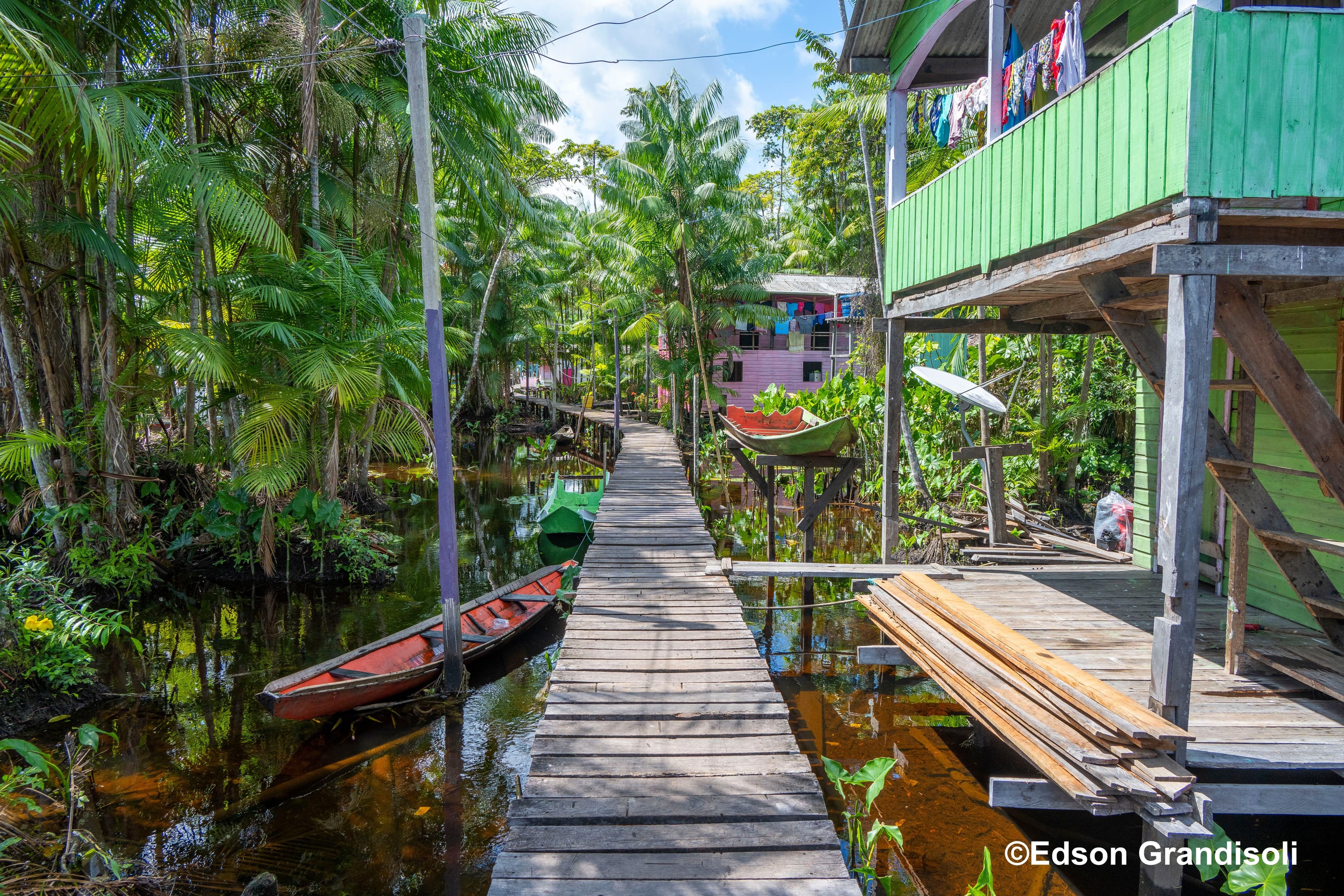
23/07/2025
Amazonian communities and circularity: new-ancestral ways of living with the forest
Prof. Dr. Edson Grandisoli*
With the collaboration of Paula Couceiro Usi**
As you navigate the Acutipereira River, you don’t see it, but it’s there, deep in the várzea (floodplain). It takes an experienced boatman to reach the Santo Ezequiel Moreno Community, in Portel, Pará, part of the Agroextractivist State Settlement Project (PEAEX) Acutipereira.
The arrival at the community, through a narrow waterway surrounded by lush vegetation, is striking for the vibrant colors and beauty of the stilt houses. And even more moving are the smiles and warm welcome from the local residents. I already knew it would be a very special day full of learning.
One of the first things that stands out is the riverside people's relationship with the water. Entering the river doesn’t require any formality. One moment you’re out of the water, the next you’re in. This seems increasingly wise in a place where the heat index often reaches 42°C — almost daily.
The water and the várzea forest — with its countless açaí palms — are not just part of the landscape. They are the landscape, and everything around is also part of the people. This relationship of closeness, respect, and mutual dependence with the environment is becoming ever rarer, and understanding the existence and persistence of alternative models of civilization and development is key for present and future generations, especially in times of socio-environmental polycrises.
Bioeconomy is an inseparable part of the Santo Ezequiel Moreno Community. Even before this term existed, the sustainable and responsible use of natural resources already demonstrated a concern for keeping the forest alive — not just standing. Thanks to the support of various partners such as Embrapa, the European Union, Sebrae/PA, IPAM (Amazon Research Institute), and CIRAD (French Agricultural Research Centre for International Development), acting under the Sustenta e Inova project — part of the global DeSIRA initiative — ancestral cultivation and management techniques have been combined with modern scientific knowledge, improving and enhancing the use of resources like açaí.
Sustenta e Inova is one of the initiatives currently underway in the community and deserves special mention. Through a co-innovation model, the project brings together local and scientific knowledge to transform the açaí value chain into a benchmark of sustainability and socioeconomic inclusion. The community plays an active role in developing and validating good management practices — from the field to commercialization — strengthening the production chain in a resilient way. The participation of women and youth in training, experimentation, and management activities has increased local leadership and opened up new economic opportunities.
The project also promotes circular economy practices, such as proper waste disposal, reuse of açaí processing residues for composting and fertilizing home gardens, and the creation of shared governance spaces for collective decision-making. The experience of Santo Ezequiel Moreno illustrates how alliances between research organizations, governments, civil society, and producers can generate innovations that address global socio-environmental challenges and create a more favorable environment for the sustainable transition of the Amazon.
These collaborative actions not only strengthen the local bioeconomy but also foster the transition to sustainable and inclusive production systems. Through participatory research and innovation processes, communities, researchers, and public and private institutions work together to create solutions tailored to local needs and capable of promoting socioeconomic development alongside the conservation of the rich várzea ecosystems.
But many challenges remain
Deforestation and fires are historic and ongoing threats in the Amazon region, placing Brazil among the top global emitters of greenhouse gases. Finding effective paths toward zero deforestation — combined with a deep renewal of how we carry out agricultural and livestock activities — would allow Brazil to reduce its gross emissions by about 75%. It may be the only country in the world with such potential, putting us at the forefront of mitigation efforts and positioning us as a global model for sustainable and circular development. The proof that this is possible lies in the heart of Marajó, in its riverside communities and their eternal bond of dependence and reverence for the forest.
The first time I set foot in the Amazon was in 1996, when I was a master’s student in the Ecology Department at the Institute of Biosciences at the University of São Paulo (USP). Since then, I’ve had the opportunity to work in the region for over 10 years. Despite my experience, the Amazon and its peoples never cease to amaze me with their creativity and resilience. The blending of different types of knowledge seems increasingly urgent to ensure the conservation of Amazonian sociobiodiversity.
I’ve been saying this for years: every Brazilian must get to know the Amazon. And not just the forest, but the people who have made it their home — and live well there. It has certainly changed, and continues to change, how I see, feel, and exist in the world.
*This text was automatically translated with the help of artificial intelligence and reviewed. Still, there may be slight differences compared to the original version in Portuguese.
*Prof. Dr. Edson Grandisoli
Ambassador and pedagogical coordinator of the Circular Movement, he holds a Master’s in Ecology, a PhD in Education and Sustainability from the University of São Paulo (USP), a postdoc in the Global Cities Program (IEA-USP), and is a specialist in Circular Economy from the UN’s UNSCC. He is also co-creator of the “Schools for the Climate” Movement, a researcher in Education, and associate editor of the journal Ambiente & Sociedade.
**Paula Couceiro
Works at Sebrae/PA coordinating international cooperation projects focused on sustainable development and innovation, such as Sustenta e Inova and AL Invest Verde, aligned with the European Union. Her main strength lies in building strategic partnerships that connect various sectors and social actors, strengthening small businesses and Amazonian communities. She mobilizes resources and initiatives that integrate bioeconomy, innovation, and sustainability, promoting collaborative solutions and positive socioeconomic impacts in the region.

